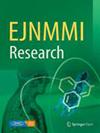Role of [18F]FAPI-04 in staging and therapeutic management of intrahepatic cholangiocarcinoma: prospective comparison with [18F]FDG PET/CT
IF 3.1
3区 医学
Q1 RADIOLOGY, NUCLEAR MEDICINE & MEDICAL IMAGING
引用次数: 0
Abstract
Fluorine-18 fluorodeoxyglucose ([18F]FDG) positron emission tomography/computed tomography (PET/CT) has some limitations in diagnosis of Intrahepatic cholangiocarcinoma (ICC). Patients with histologically confirmed ICC who underwent both [18F]FDG and 18F-labeled fibroblast-activation protein inhibitors ([18F]FAPI)-04 PET/CT were prospectively analyzed. The maximum standard uptake value (SUVmax), tumor-to-background ratio (TBR), metabolic tumor volume (MTV), total lesion glycolysis (TLG), [18F]FAPI–avid tumor volume (FTV), total lesion fibroblast activation protein expression (TLF) were compared between the two modalities by paired Wilcoxon signed-rank test and Mann–Whitney U test, and McNemar’s test was used to assess the diagnostic accuracy between the two techniques. In total, 23 patients with 389 lesions were included. Compared to [18F]FDG, [18F]F-FAPI-04 PET/CT demonstrated a higher detection rate for intrahepatic lesions (86.3% vs. 78.2% P = 0.040), lymph node metastases (85.2% vs. 68.2%, P = 0.007), peritoneal metastases (100% vs. 93.8%), and bone metastases (100% vs. 70.5%, P < 0.001). [18F]FAPI-04 PET showed higher SUVmax, TBR and greater tumor burden values than [18F]FDG PET in non-cholangitis intrahepatic lesions (SUVmax: 8.7 vs. 6.4, P < 0.001; TBR: 8.0 vs. 3.5, P < 0.001; FTV vs. MTV: 41.3 vs. 12.4, P < 0.001; TLF vs. TLG: 223.5 vs. 57.0, P < 0.001), lymph node metastases (SUVmax: 6.5 vs. 5.5, P = 0.042; TBR: 5.4 vs. 3.9, P < 0.001; FTV vs. MTV: 2.0 vs. 1.5, P = 0.026; TLF vs. TLG: 9.0 vs. 7.8 P = 0.024), and bone metastases (SUVmax: 9.7 vs. 5.25, P < 0.001; TBR: 10.8 vs. 3.0, P < 0.001; TLF vs. TLG: 9.8 vs. 4.2, P < 0.001). However, [18F]FDG showed higher radiotracer uptake (SUVmax: 14.7 vs. 8.4, P < 0.001; TBR: 7.4 vs. 2.8, P < 0.001) than [18F]FAPI-04 PET/CT for 6 patients with obstructive cholangitis. [18F]FAPI-04 PET/CT yielded a change in planned therapy in 6 of 23 (26.1%) patients compared with [18F]FDG. [18F]FAPI-04 PET/CT had higher detection rate and radiotracer uptake than [18F]FDG PET/CT in intrahepatic lesions, lymph node metastases, and distant metastases, especially in bone. Therefore, [18F]FAPI-04 PET/CT may be a promising technique for diagnosis and staging of ICC. Clinical Trials, NCT05485792. Registered 1 August 2022, retrospectively registered, https//clinicaltrials.gov/study/NCT05485792?cond=NCT05485792&rank=1.18F]FAPI-04 在肝内胆管癌分期和治疗管理中的作用:与 [18F]FDG PET/CT 的前瞻性比较
氟-18脱氧葡萄糖([18F]FDG)正电子发射断层扫描/计算机断层扫描(PET/CT)在诊断肝内胆管癌(ICC)方面存在一些局限性。我们对同时接受[18F]FDG和18F标记成纤维细胞活化蛋白抑制剂([18F]FAPI)-04 PET/CT检查的组织学确诊ICC患者进行了前瞻性分析。通过配对 Wilcoxon 符号秩检验和 Mann-Whitney U 检验比较了两种方法的最大标准摄取值(SUVmax)、肿瘤与背景比(TBR)、代谢肿瘤体积(MTV)、总病灶糖酵解(TLG)、[18F]FAPI-avid 肿瘤体积(FTV)、总病灶成纤维细胞活化蛋白表达(TLF),并用 McNemar 检验评估了两种技术的诊断准确性。共纳入了 23 名患者的 389 个病灶。与[18F]FDG相比,[18F]F-FAPI-04 PET/CT对肝内病变(86.3% 对 78.2%,P = 0.040)、淋巴结转移(85.2% 对 68.2%,P = 0.007)、腹膜转移(100% 对 93.8%)和骨转移(100% 对 70.5%,P < 0.001)的检出率更高。在非胆管炎肝内病变中,[18F]FAPI-04 PET显示出比[18F]FDG PET更高的SUVmax、TBR和更大的肿瘤负荷值(SUVmax:8.7 vs. 6.4,P <0.001;TBR:8.0 vs. 3.5,P <0.001;FTV vs. MTV:41.3 vs. 12.4,P <0.001):41.3 vs. 12.4,P < 0.001;TLF vs. TLG:223.5 vs. 57.0,P < 0.001)、淋巴结转移(SUVmax:6.5 vs. 5.5,P = 0.042;TBR:5.4 vs. 3.9,P < 0.001;FTV vs. MTV:2.0 vs. 1.5, P = 0.026; TLF vs. TLG: 9.0 vs. 7.8 P = 0.024)和骨转移(SUVmax:9.7 vs. 5.25, P < 0.001; TBR: 10.8 vs. 3.0, P < 0.001; TLF vs. TLG: 9.8 vs. 4.2, P < 0.001)。然而,在6例阻塞性胆管炎患者中,[18F]FDG的放射性示踪剂摄取量(SUVmax:14.7 vs. 8.4,P < 0.001;TBR:7.4 vs. 2.8,P < 0.001)高于[18F]FAPI-04 PET/CT。与[18F]FDG相比,[18F]FAPI-04 PET/CT 使 23 例患者中的 6 例(26.1%)改变了治疗计划。与[18F]FDG PET/CT 相比,[18F]FAPI-04 PET/CT 对肝内病灶、淋巴结转移和远处转移(尤其是骨转移)的检出率和放射性示踪剂摄取率更高。因此,[18F]FAPI-04 PET/CT 可能是一种很有前途的 ICC 诊断和分期技术。临床试验,NCT05485792。2022年8月1日注册,回顾性注册,https//clinicaltrials.gov/study/NCT05485792?cond=NCT05485792&rank=1。
本文章由计算机程序翻译,如有差异,请以英文原文为准。
求助全文
约1分钟内获得全文
求助全文
来源期刊

EJNMMI Research
RADIOLOGY, NUCLEAR MEDICINE & MEDICAL IMAGING&nb-
CiteScore
5.90
自引率
3.10%
发文量
72
审稿时长
13 weeks
期刊介绍:
EJNMMI Research publishes new basic, translational and clinical research in the field of nuclear medicine and molecular imaging. Regular features include original research articles, rapid communication of preliminary data on innovative research, interesting case reports, editorials, and letters to the editor. Educational articles on basic sciences, fundamental aspects and controversy related to pre-clinical and clinical research or ethical aspects of research are also welcome. Timely reviews provide updates on current applications, issues in imaging research and translational aspects of nuclear medicine and molecular imaging technologies.
The main emphasis is placed on the development of targeted imaging with radiopharmaceuticals within the broader context of molecular probes to enhance understanding and characterisation of the complex biological processes underlying disease and to develop, test and guide new treatment modalities, including radionuclide therapy.
 求助内容:
求助内容: 应助结果提醒方式:
应助结果提醒方式:


